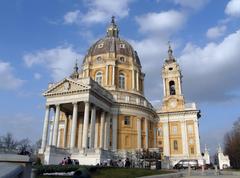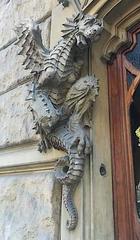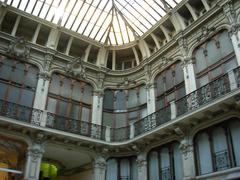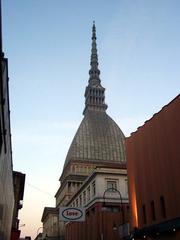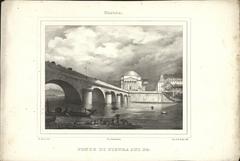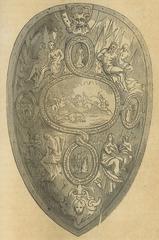Visiting Piazza CLN: Hours, Tickets, and Historical Insights
Date: 19/07/2024
Introduction
Piazza CLN, nestled in the enchanting town of Chieri, Italy, is a captivating blend of history, architecture, and cultural significance. This square, named after the Comitato di Liberazione Nazionale (National Liberation Committee), stands as a memorial to the Italian resistance movement during World War II. Chieri itself, known as Carreum Potentia in Roman times, has a rich historical tapestry that is vividly reflected in Piazza CLN. Visitors to Piazza CLN are greeted with architectural marvels like the fountains of Po and Dora designed by Umberto Baglioni and the nearby Church of Santa Maria della Scala, adding layers of artistic and historical depth. This guide delves into the historical background, architectural highlights, practical visiting information, and nearby attractions, providing a comprehensive look at why Piazza CLN is a must-visit destination for history enthusiasts, art lovers, and curious travelers alike.
Table of Contents
- [Introduction](#introductionintroduction)
- [Historical Background of Piazza CLN](#historical-background-of-piazza-clnhistorical-background-of-piazza-cln)
- [Origins and Early Development](#origins-and-early-developmentorigins-and-early-development)
- [Medieval Period](#medieval-periodmedieval-period)
- [Renaissance and Baroque Influence](#renaissance-and-baroque-influencerenaissance-and-baroque-influence)
- [19th Century - Unification of Italy](#19th-century---unification-of-italy19th-century---unification-of-italy)
- [20th Century - World War II and Beyond](#20th-century---world-war-ii-and-beyond20th-century---world-war-ii-and-beyond)
- [Visiting Piazza CLN - Practical Information](#visiting-piazza-cln---practical-informationvisiting-piazza-cln---practical-information)
- [Piazza CLN Visiting Hours](#piazza-cln-visiting-hourspiazza-cln-visiting-hours)
- [Tickets and Guided Tours](#tickets-and-guided-tourstickets-and-guided-tours)
- [Architectural Highlights](#architectural-highlightsarchitectural-highlights)
- [Cultural Significance and Events](#cultural-significance-and-eventscultural-significance-and-events)
- [Nearby Attractions and Travel Tips](#nearby-attractions-and-travel-tipsnearby-attractions-and-travel-tips)
- [Accessibility](#accessibilityaccessibility)
- [FAQ Section](#faq-sectionfaq-section)
- [Conclusion](#conclusionconclusion)
- [Sources](#sourcessources)
Historical Background of Piazza CLN
Origins and Early Development
Piazza CLN’s origins can be traced back to the Roman era when Chieri, known as Carreum Potentia, was a thriving Roman settlement. The area that is now Piazza CLN was likely a central point in the Roman town, serving as a forum or marketplace where citizens gathered for trade and social activities.
Medieval Period
During the medieval period, Chieri experienced significant growth and development. The town became an important center for commerce and craftsmanship, particularly in the textile industry. Piazza CLN, although not yet known by its current name, continued to serve as a focal point for the community. The square was surrounded by important buildings, including churches and guild halls, reflecting the town’s prosperity.
Renaissance and Baroque Influence
The Renaissance and Baroque periods brought further transformation to Piazza CLN. The square was redesigned to reflect the architectural styles of the time, with elegant facades and ornate decorations. This era saw the construction of several notable buildings around the square, including palaces and civic structures that showcased the wealth and artistic sensibilities of Chieri’s elite.
19th Century - Unification of Italy
The 19th century was a period of significant change for Italy, culminating in the unification of the country in 1861. Piazza CLN became a site of political and social activity. It was during this time that the square began to take on a more modern appearance, with the addition of new buildings and the renovation of existing structures.
20th Century - World War II and Beyond
The 20th century brought both challenges and opportunities for Piazza CLN. During World War II, Chieri experienced significant hardship. The square was named Piazza CLN in honor of the Comitato di Liberazione Nazionale (National Liberation Committee), which played a crucial role in the Italian resistance movement. Post-war reconstruction led to the modernization of Piazza CLN, blending historical significance with contemporary amenities.
Visiting Piazza CLN - Practical Information
Piazza CLN Visiting Hours
Piazza CLN is open to the public 24 hours a day, seven days a week. However, specific attractions within the square, such as museums or guided tours, may have their own visiting hours. It is recommended to check the official websites or contact local tourist information centers for the most current visiting hours.
Tickets and Guided Tours
Visiting Piazza CLN itself does not require a ticket as it is a public space. However, guided tours that provide in-depth historical context and access to specific sites may require tickets. These tours can be booked through local tour operators or online platforms. Prices vary depending on the type and duration of the tour.
Architectural Highlights
Piazza CLN is home to several architectural highlights that reflect its rich history. One of the most notable features is the pair of fountains representing the rivers Po and Dora, designed by Umberto Baglioni in the 1930s. These fountains are a symbol of the city’s connection to its natural surroundings.
Another significant building is the Church of Santa Maria della Scala, which dates back to the 11th century. Although not directly on the square, its proximity adds to the historical ambiance of the area. The church has undergone numerous renovations over the centuries, each adding layers of architectural and artistic significance.
Cultural Significance and Events
Piazza CLN is not just a historical site; it is also a cultural hub for the city of Chieri. The square hosts various events throughout the year, including markets, festivals, and public gatherings. These events draw both locals and tourists, making Piazza CLN a vibrant part of the city’s social fabric.
Local artists often use the square as a backdrop for their work, and it is a popular location for outdoor performances and exhibitions. This blend of history and contemporary culture makes Piazza CLN a unique and engaging destination for visitors.
Nearby Attractions and Travel Tips
Accessibility
Piazza CLN is accessible to visitors with disabilities. The square’s flat terrain and paved surfaces make it easy to navigate. Some buildings and attractions may have additional accessibility features, so it’s advisable to check ahead of your visit.
Best Time to Visit
The best time to visit Piazza CLN is during the spring and autumn months when the weather is mild and pleasant. These seasons also coincide with various local festivals and events, providing visitors with a richer cultural experience.
Local Cuisine
Chieri is renowned for its culinary heritage. Visitors should try traditional Piedmontese dishes such as agnolotti and bagna cauda. Numerous cafes and restaurants around the piazza offer a variety of local and international cuisines.
Nearby Attractions
Visitors to Piazza CLN can also explore several nearby attractions. The Chieri Cathedral, known for its stunning Gothic architecture, is just a short walk away. The Museo del Tessile, which showcases the region’s rich textile history, is another must-visit. Additionally, the nearby Parco della Collina di Superga offers breathtaking views and hiking trails for nature enthusiasts.
FAQ Section
What are the visiting hours for Piazza CLN?
Piazza CLN is open to the public 24/7. Specific attractions within the square may have their own visiting hours.
Are guided tours available at Piazza CLN?
Yes, guided tours are available and can be booked through local tour operators or online platforms.
Is there an entry fee for Piazza CLN?
No, Piazza CLN itself is a public space and does not require an entry fee.
What are some nearby attractions?
Nearby attractions include the Church of Santa Maria della Scala, Chieri Cathedral, and various local museums.
Conclusion
Piazza CLN is a testament to the rich history and cultural heritage of Chieri. From its origins in the Roman era to its modern-day significance, the square has played a central role in the life of the city. Its architectural highlights, cultural events, and historical significance make it a fascinating destination for visitors from around the world.
For those interested in learning more, guided tours are available that provide in-depth information about the square’s past and present. Whether you’re a history buff, an art lover, or simply looking to explore a beautiful part of Chieri, Piazza CLN offers something for everyone.
Stay updated on events and news about Piazza CLN by following local social media channels or downloading the Audiala mobile app for more information and updates.
